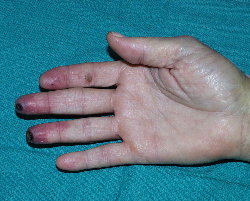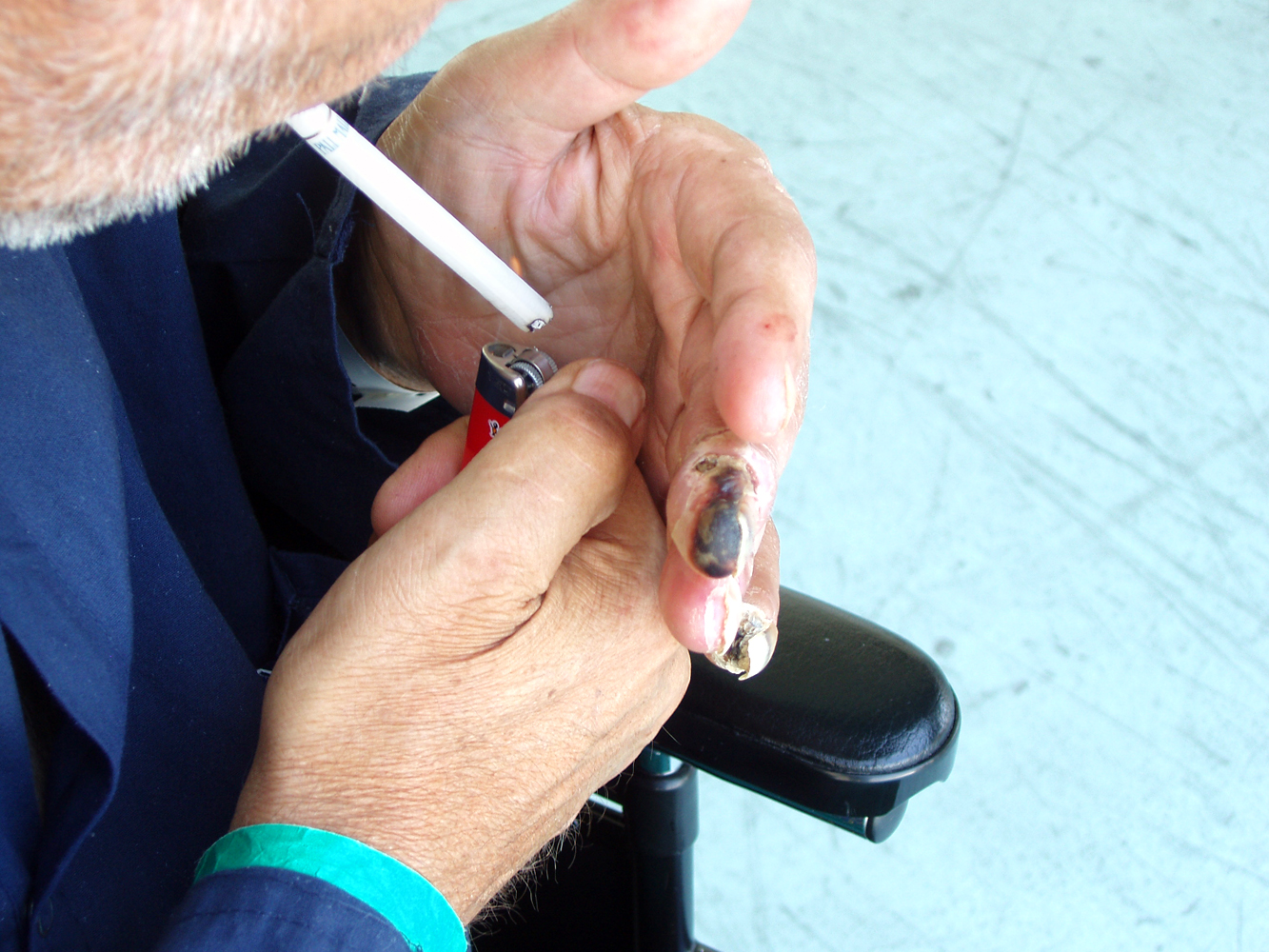Buergers disease
| Buerger's disease | ||
 | ||
|---|---|---|
| Buerger's Disease of the Hand | ||
| ICD-10 | I73.1 | |
| ICD-9 | 443.1 | |
| OMIM | 211480 | |
| DiseasesDB | 1762 | |
| eMedicine | med/253 | |
| MeSH | C14.907.137.870 | |
Template:Search infobox Editor-In-Chief: C. Michael Gibson, M.S., M.D. [1]
Please Take Over This Page and Apply to be Editor-In-Chief for this topic: There can be one or more than one Editor-In-Chief. You may also apply to be an Associate Editor-In-Chief of one of the subtopics below. Please mail us [2] to indicate your interest in serving either as an Editor-In-Chief of the entire topic or as an Associate Editor-In-Chief for a subtopic. Please be sure to attach your CV and or biographical sketch.
- Not to be confused with Berger's disease (IgA nephropathy)
Overview
Buerger's disease (also known as thromboangiitis obliterans) is an acute inflammation and thrombosis (clotting) of arteries and veins of the hands and feet. It is strongly associated with use of tobacco products,[1] primarily from smoking, but also from smokeless tobacco. It is more often seen in men. There may be an autoimmune element as well. Raynaud’s phenomenon, ulcers and pain are typically seen. Immediate termination of smoking is essential.
Features
There is a recurrent acute and chronic inflammation and thrombosis of arteries and veins of the hands and feet. The main symptom is pain in the affected areas. Ulcerations and gangrene in the extremities are common complications, often resulting in the need for amputation of the involved extremity.
Diagnosis
A concrete diagnosis of thromboangiitis obliterans is often difficult as it relies heavily on exclusion of the conditions. The commonly followed diagnostic criteria are below although the criteria tend to differ slightly from author to author. Olin (2000) proposes the following criteria:[2]
- Age younger than 45 years
- Current (or recent) history of tobacco use
- Presence of distal extremity ischemia (indicated by claudication, pain at rest, ischemic ulcers or gangrene) documented by noninvasive vascular testing such as ultrasound
- Exclusion of autoimmune diseases, hypercoagulable states, and diabetes mellitus by laboratory tests.
- Exclusion of a proximal source of emboli by echocardiography and arteriography
- Consistent arteriographic findings in the clinically involved and noninvolved limbs.
Diagnostic Findings
-
Thromboangiitis Obliterans (Buerger's disease): Arterial vascular disease associated with smoking. Note the blackened tips of middle and pinky fingers.
(Image courtesy of Charlie Goldberg, M.D.)
Pathophysiology
There are characteristic pathologic findings of acute inflammation and thrombosis (clotting) of arteries and veins of the hands and feet (the lower limbs being more common). The mechanisms underlying Buerger's disease are still largely unknown. It is suspected that immunological reactions play a role.
Treatment
Symptoms are treated as there is no treatment for the disease. Cessation of tobacco use may slow any further progression of the disease. Vascular surgery can sometimes be helpful in treating limbs with poor perfusion secondary to this disease. Use of vascular growth factor and stem cell injections have been showing promise in clinical studies.
Prognosis
Amputation is common and more severe in patients who continue to use tobacco. It often leads to vascular insufficiency. Buerger's is rarely immediately fatal, but rather a life shortening disease.
Prevention
The cause of the disease is unknown but heavily linked to tobacco use. There have also been links to persons with digestive disorders.
Epidemiology
Buerger's is more common among men than women. It is more common in Israel, Japan and India along the "old silk route" than in the United States and Europe. The disease is most common among South Asians, who often smoke cigarettes made of raw tobacco (bidis).
History
Buerger's disease was first reported by Felix Von Winiwater in 1879 in Germany. [3]
It was described in detail by Leo Buerger in 1908 in New York,[4] who called it presenile spontaneous gangrene after studying amputations in 11 patients.
Pathology
<youtube v=whJF412vi2g/>
References
- ↑ Joyce JW (1990). "Buerger's disease (thromboangiitis obliterans)". Rheum Dis Clin North Am. 16 (2): 463–70. PMID 2189162.
- ↑ Olin JW. Thromboangiitis obliterans (Buerger's disease). N Engl J Med 2000;343:864-9. PMID 10995867.
- ↑ von Winiwarter F: Ueber eine eigenthumliche Form von Endarteriitis und Endophlebitis mit Gangran des Fusses. Arch Klin Chir 1879; 23: 202-26.
- ↑ Buerger L. Thrombo-angiitis obliterans: a study of the vascular lesions leading to presenile spontaneous gangrene. Am J Med Sci 1908;136:567-80.
External Links
External links
de:Endangiitis obliterans he:מחלת בירגר nl:Ziekte van Buerger sv:Morbus Buerger
